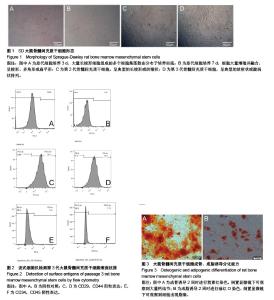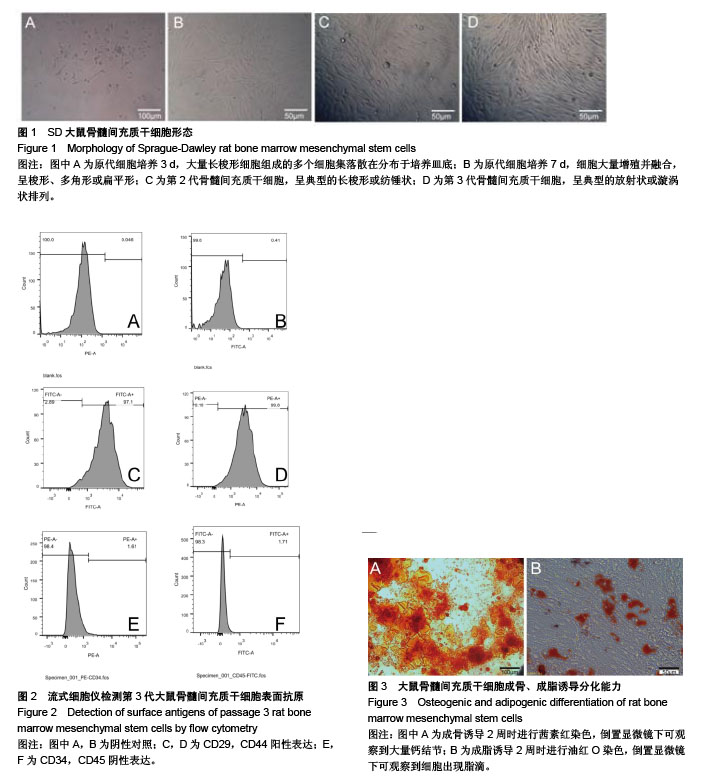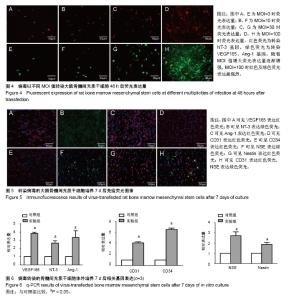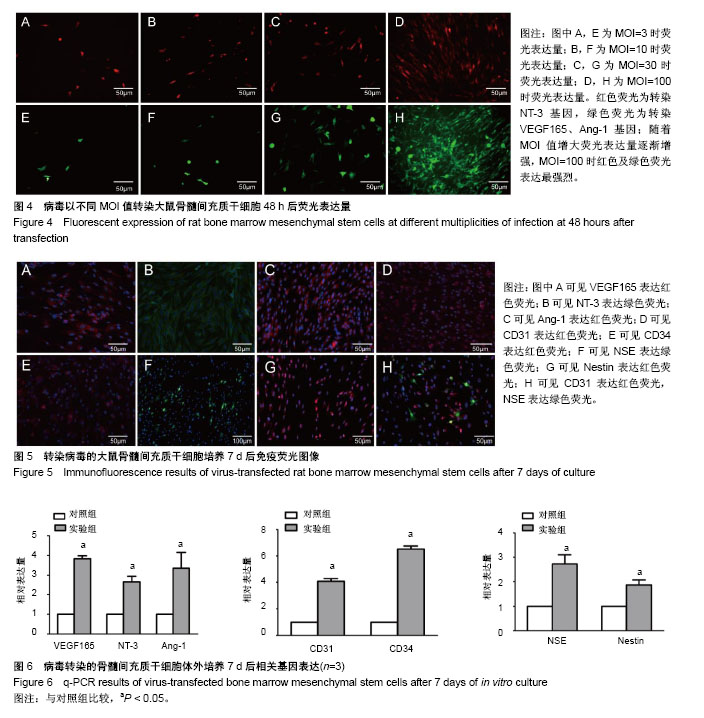Chinese Journal of Tissue Engineering Research ›› 2018, Vol. 22 ›› Issue (25): 3956-3962.doi: 10.3969/j.issn.2095-4344.0909
Previous Articles Next Articles
Transfection with vascular endothelial growth factor 165, neurotrophin 3 and angiopoietin 1 induces the differentiation of bone marrow mesenchymal stem cells into neurons and vascular endothelial cells
Jiang Xing-hai, Zhao Biao, Wu Kai, Xiao Ren-shun, Wang Xiao-mei
- Second Affiliated Hospital of Nanchang University, Nanchang 330000, Jiangxi Province, China
-
Revised:2018-02-25Online:2018-09-08Published:2018-09-08 -
Contact:Song Yu-lin, M.D., Chief physician, Second Affiliated Hospital of Nanchang University, Nanchang 330000, Jiangxi Province, China -
About author:Jiang Xing-hai, Master, Physician, Second Affiliated Hospital of Nanchang University, Nanchang 330000, Jiangxi Province, China -
Supported by:the National Natural Science Foundation of China, No. 30801158, 81360271; the Natural Science Foundation of Jiangxi Province, No. 20151BAB205051; the Project of Jiangxi Provincial Department of Education, No. GJJ09086, GJJ14054; the Project of Jiangxi Provincial Department of Health, No. 20081078
CLC Number:
Cite this article
Jiang Xing-hai, Zhao Biao, Wu Kai, Xiao Ren-shun, Wang Xiao-mei. Transfection with vascular endothelial growth factor 165, neurotrophin 3 and angiopoietin 1 induces the differentiation of bone marrow mesenchymal stem cells into neurons and vascular endothelial cells[J]. Chinese Journal of Tissue Engineering Research, 2018, 22(25): 3956-3962.
share this article

2.1 大鼠骨髓间充质干细胞形态及鉴定结果 细胞接种培养48 h后,倒置显微镜下可见少量梭形细胞开始贴壁生长,接种第3天显微镜下观察可见由大量长梭形细胞组成的多个细胞集落散在分布于培养皿底(图1A),培养7 d后细胞大量增殖并融合,呈梭形、多角形或扁平形(图1B)。传至第2,3代的单个细胞形态呈典型的长梭形或纺锤状,融合后呈放射状或漩涡状排列(图1C,D)。 大鼠骨髓间充质干细胞免疫表型鉴定:见图2。流式细胞术检测结果显示间充质干细胞表面分子CD29、CD44阳性表达率为97.1%,99.8%(图2C,D),造血干细胞表面分子CD34、CD45阳性表达率为1.61%,1.71%(图2E,F)。 大鼠骨髓间充质干细胞成骨、成脂诱导分化能力:骨髓间充质干细胞在成骨诱导2周时进行茜素红染色,倒置显微镜下可观察到大量钙结节(图3A);成脂诱导2周时进行油红O染色,倒置显微镜下可观察到细胞出现脂滴(图3B)。 2.2 病毒转染最佳MOI值 以不同MOI值将Adv-Bic(绿色荧光)及AdvNT-3(红色荧光)同时转染大鼠骨髓间充质干细胞,培养2 d后,荧光显微镜下观察。随着MOI值增高,绿色及红色荧光表达量均相应增多,当MOI=100时两种荧光到达高峰(图4A-H)。MOI为300时部分细胞死亡,MOI为1 000时大量细胞死亡。因此,MOI=100时能达到最佳的转染效果。 2.3 免疫荧光检测结果 转染VEGF165、NT-3、Ang-1基因的骨髓间充质干细胞在体外培养7 d后,通过免疫荧光检测VEGF165、NT-3、Ang-1均阳性表达(图5A-C)。血管内皮标记物CD31,CD34均阳性表达(图5D,E,H);神经元相关标记物NSE、Nestin均阳性表达(图5F-H)。 2.4 实时荧光定量PCR(qRT-PCR)检测结果 实验组中转染的目的基因VEGF165、NT-3、Ang-1表达水平均明显高于对照组(P < 0.05);实验组血管内皮细胞相关基因CD31、CD34表达水平明显高于对照组(P < 0.05);实验组神经元相关基因NSE、Nestin表达水平明显高于对照组(P < 0.05),见图6。"

| [1] Fan WL, Liu P, Wang G, et al. Transplantation of hypoxic preconditioned neural stem cells benefits functional recovery via enhancing neurotrophic secretion after spinal cord injury in rats. J Cell Biochem. 2017 Sep 8. doi: 10.1002/jcb.26397. [Epub ahead of print][2] Suzuki H, Ahuja CS, Salewski RP, et al. Neural stem cell mediated recovery is enhanced by Chondroitinase ABC pretreatment in chronic cervical spinal cord injury. PLoS One. 2017;12(8):e0182339.[3] Ao Q, Wang AJ, Chen GQ, et al. Combined transplantation of neural stem cells and olfactory ensheathing cells for the repair of spinal cord injuries. Med Hypotheses. 2007;69(6):1234-1237.[4] Stewart AN, Kendziorski G, Deak ZM, et al. Co-transplantation of mesenchymal and neural stem cells and overexpressing stromal-derived factor-1 for treating spinal cord injury. Brain Res. 2017; 1672:91-105.[5] He X, Li L, Tang M, et al. Biomimetic electrical stimulation induces rat bone marrow mesenchymal stem cells to differentiate into cardiomyocyte-like cells via TGF-beta 1 in vitro. Prog Biophys Mol Biol. 2017 Sep 29. doi: 10.1016/j.pbiomolbio.2017.09.023. [Epub ahead of print][6] Guo S, Zhen Y, Wang A. Transplantation of bone mesenchymal stem cells promotes angiogenesis and improves neurological function after traumatic brain injury in mouse. Neuropsychiatr Dis Treat. 2017;13: 2757-2765.[7] Cai S, Tsui YP, Tam KW, et al. Directed Differentiation of Human Bone Marrow Stromal Cells to Fate-Committed Schwann Cells. Stem Cell Reports. 2017;9(4):1097-1108.[8] Zhang H, Wang L, Wen S, et al. Magnetic resonance imaging tracking and assessing repair function of the bone marrow mesenchymal stem cells transplantation in a rat model of spinal cord injury. Oncotarget. 2017;8(35):58985-58999.[9] Pu Y, Meng K, Gu C, et al. Thrombospondin-1 modified bone marrow mesenchymal stem cells (BMSCs) promote neurite outgrowth and functional recovery in rats with spinal cord injury. Oncotarget. 2017; 8(56):96276-96289.[10] 莫翠萍,王家传,周光前,等.骨髓间充质干细胞移植治疗大鼠脊髓损伤的神经分化研究[J].中华细胞与干细胞杂志:电子版, 2015,5(4):33-39.[11] Ye Y, Feng TT, Peng YR, et al. The treatment of spinal cord injury in rats using bone marrow-derived neural-like cells induced by cerebrospinal fluid. Neurosci Lett. 2018;666:85-91. [12] 司翠平,卞合涛,闫中瑞,等.Wnt信号在骨髓间充质干细胞神经分化中的研究进展[J].中华脑科疾病与康复杂志:电子版, 2015,5(3):192-195.[13] Zhang W, Zeng YS, Zhang XB, et al. Combination of adenoviral vector-mediated neurotrophin-3 gene transfer and retinoic acid promotes adult bone marrow cells to differentiate into neuronal phenotypes. Neurosci Lett. 2006;408(2):98-103.[14] Polisetti N, Chaitanya VG, Babu PP, et al. Isolation, characterization and differentiation potential of rat bone marrow stromal cells. Neurol India. 2010;58(2):201-208.[15] Zhang W, Zhang F, Shi H, et al. Comparisons of rabbit bone marrow mesenchymal stem cell isolation and culture methods in vitro. PLoS One. 2014;9(2):e88794.[16] Zhu X, Du J, Liu G. The comparison of multilineage differentiation of bone marrow and adipose-derived mesenchymal stem cells. Clin Lab. 2012;58(9-10):897-903.[17] Song K, Huang M, Shi Q, et al. Cultivation and identification of rat bone marrow-derived mesenchymal stem cells. Mol Med Rep. 2014;10(2): 755-760.[18] Niu CC, Lin SS, Yuan LJ, et al. Identification of mesenchymal stem cells and osteogenic factors in bone marrow aspirate and peripheral blood for spinal fusion by flow cytometry and proteomic analysis. J Orthop Surg Res. 2014;9:32.[19] Zhang HT, Liu ZL, Yao XQ, et al. Neural differentiation ability of mesenchymal stromal cells from bone marrow and adipose tissue: a comparative study. Cytotherapy. 2012;14(10):1203-1214.[20] Hofstetter CP, Schwarz EJ, Hess D, et al. Marrow stromal cells form guiding strands in the injured spinal cord and promote recovery. Proc Natl Acad Sci U S A. 2002;99(4):2199-2204.[21] Han S, Wang B, Li X, et al. Bone marrow-derived mesenchymal stem cells in three-dimensional culture promote neuronal regeneration by neurotrophic protection and immunomodulation. J Biomed Mater Res A. 2016;104(7):1759-1769.[22] Feng L, Gan H, Zhao W, et al. Effect of transplantation of olfactory ensheathing cell conditioned medium induced bone marrow stromal cells on rats with spinal cord injury. Mol Med Rep. 2017;16(2): 1661-1668.[23] Bronckaers A, Hilkens P, Martens W, et al. Mesenchymal stem/stromal cells as a pharmacological and therapeutic approach to accelerate angiogenesis. Pharmacol Ther. 2014;143(2):181-196.[24] Lin RZ, Melero-Martin JM. Fibroblast growth factor-2 facilitates rapid anastomosis formation between bioengineered human vascular networks and living vasculature. Methods. 2012;56(3):440-451.[25] Ng YS, Krilleke D, Shima DT. VEGF function in vascular pathogenesis. Exp Cell Res. 2006;312(5):527-537.[26] Kim HM, Hwang DH, Lee JE, et al. Ex vivo VEGF delivery by neural stem cells enhances proliferation of glial progenitors, angiogenesis, and tissue sparing after spinal cord injury. PLoS One. 2009;4(3): e4987.[27] Ng MT, Stammers AT, Kwon BK. Vascular disruption and the role of angiogenic proteins after spinal cord injury. Transl Stroke Res. 2011; 2(4):474-491.[28] Herrera JJ, Sundberg LM, Zentilin L, et al. Sustained expression of vascular endothelial growth factor and angiopoietin-1 improves blood-spinal cord barrier integrity and functional recovery after spinal cord injury. J Neurotrauma. 2010;27(11):2067-2076.[29] Bai Y, Yin G, Huang Z, et al. Localized delivery of growth factors for angiogenesis and bone formation in tissue engineering. Int Immunopharmacol. 2013;16(2):214-223.[30] Zhang YJ, Zhang W, Lin CG, et al. Neurotrophin-3 gene modified mesenchymal stem cells promote remyelination and functional recovery in the demyelinated spinal cord of rats. J Neurol Sci. 2012; 313(1-2):64-74. |
| [1] | Pu Rui, Chen Ziyang, Yuan Lingyan. Characteristics and effects of exosomes from different cell sources in cardioprotection [J]. Chinese Journal of Tissue Engineering Research, 2021, 25(在线): 1-. |
| [2] | Lin Qingfan, Xie Yixin, Chen Wanqing, Ye Zhenzhong, Chen Youfang. Human placenta-derived mesenchymal stem cell conditioned medium can upregulate BeWo cell viability and zonula occludens expression under hypoxia [J]. Chinese Journal of Tissue Engineering Research, 2021, 25(在线): 4970-4975. |
| [3] | Zhang Tongtong, Wang Zhonghua, Wen Jie, Song Yuxin, Liu Lin. Application of three-dimensional printing model in surgical resection and reconstruction of cervical tumor [J]. Chinese Journal of Tissue Engineering Research, 2021, 25(9): 1335-1339. |
| [4] | Hou Jingying, Yu Menglei, Guo Tianzhu, Long Huibao, Wu Hao. Hypoxia preconditioning promotes bone marrow mesenchymal stem cells survival and vascularization through the activation of HIF-1α/MALAT1/VEGFA pathway [J]. Chinese Journal of Tissue Engineering Research, 2021, 25(7): 985-990. |
| [5] | Shi Yangyang, Qin Yingfei, Wu Fuling, He Xiao, Zhang Xuejing. Pretreatment of placental mesenchymal stem cells to prevent bronchiolitis in mice [J]. Chinese Journal of Tissue Engineering Research, 2021, 25(7): 991-995. |
| [6] | Liang Xueqi, Guo Lijiao, Chen Hejie, Wu Jie, Sun Yaqi, Xing Zhikun, Zou Hailiang, Chen Xueling, Wu Xiangwei. Alveolar echinococcosis protoscolices inhibits the differentiation of bone marrow mesenchymal stem cells into fibroblasts [J]. Chinese Journal of Tissue Engineering Research, 2021, 25(7): 996-1001. |
| [7] | Fan Quanbao, Luo Huina, Wang Bingyun, Chen Shengfeng, Cui Lianxu, Jiang Wenkang, Zhao Mingming, Wang Jingjing, Luo Dongzhang, Chen Zhisheng, Bai Yinshan, Liu Canying, Zhang Hui. Biological characteristics of canine adipose-derived mesenchymal stem cells cultured in hypoxia [J]. Chinese Journal of Tissue Engineering Research, 2021, 25(7): 1002-1007. |
| [8] | Geng Yao, Yin Zhiliang, Li Xingping, Xiao Dongqin, Hou Weiguang. Role of hsa-miRNA-223-3p in regulating osteogenic differentiation of human bone marrow mesenchymal stem cells [J]. Chinese Journal of Tissue Engineering Research, 2021, 25(7): 1008-1013. |
| [9] | Lun Zhigang, Jin Jing, Wang Tianyan, Li Aimin. Effect of peroxiredoxin 6 on proliferation and differentiation of bone marrow mesenchymal stem cells into neural lineage in vitro [J]. Chinese Journal of Tissue Engineering Research, 2021, 25(7): 1014-1018. |
| [10] | Zhu Xuefen, Huang Cheng, Ding Jian, Dai Yongping, Liu Yuanbing, Le Lixiang, Wang Liangliang, Yang Jiandong. Mechanism of bone marrow mesenchymal stem cells differentiation into functional neurons induced by glial cell line derived neurotrophic factor [J]. Chinese Journal of Tissue Engineering Research, 2021, 25(7): 1019-1025. |
| [11] | Duan Liyun, Cao Xiaocang. Human placenta mesenchymal stem cells-derived extracellular vesicles regulate collagen deposition in intestinal mucosa of mice with colitis [J]. Chinese Journal of Tissue Engineering Research, 2021, 25(7): 1026-1031. |
| [12] | Pei Lili, Sun Guicai, Wang Di. Salvianolic acid B inhibits oxidative damage of bone marrow mesenchymal stem cells and promotes differentiation into cardiomyocytes [J]. Chinese Journal of Tissue Engineering Research, 2021, 25(7): 1032-1036. |
| [13] | Wang Xianyao, Guan Yalin, Liu Zhongshan. Strategies for improving the therapeutic efficacy of mesenchymal stem cells in the treatment of nonhealing wounds [J]. Chinese Journal of Tissue Engineering Research, 2021, 25(7): 1081-1087. |
| [14] | Wang Shiqi, Zhang Jinsheng. Effects of Chinese medicine on proliferation, differentiation and aging of bone marrow mesenchymal stem cells regulating ischemia-hypoxia microenvironment [J]. Chinese Journal of Tissue Engineering Research, 2021, 25(7): 1129-1134. |
| [15] | Zeng Yanhua, Hao Yanlei. In vitro culture and purification of Schwann cells: a systematic review [J]. Chinese Journal of Tissue Engineering Research, 2021, 25(7): 1135-1141. |
| Viewed | ||||||
|
Full text |
|
|||||
|
Abstract |
|
|||||

